#Animism
Text
I am TELLING YOU if you have spent months, years, around the same trees, land, etc., they WILL recognize you and reach out to you or not mind if you reach out to them. You don’t need to know anything about them.
A tree in the forest behind my parents house I’ve never spoken to before reached out - I never would’ve expected it. I don’t know what kind of tree it is. But of course this tree knows me. This tree has known me since I was six.
Trust me. This land knows you. These plants know you. They want to speak with you.
#personal#witchblr#witchcraft#witchy#magick#nature#spirituality#witchy vibes#green witch#green witchery#green witchcraft#spiritual growth#spirit work#spirit witch#animism#nature spirits#tree spirits#tree spirit#land spirits#land spirit#spirit communication#baby witch#baby witch tips
1K notes
·
View notes
Text
I find that so much of Heathenry comes from participation with the immediate, physical world around me; from being part of the landscape of nature.
I went for a walk today and found a spot with a nice view. The flat landscape opened up the world and the sky before me, and I just sat there and looked/listened to what the phenomena I experienced told me about themselves.
The wind shares things from miles away. She keeps no secrets. My guess is that it's a big factor in how this region talks to itself.
The weather front along the distant mountains seemed restless, like a restless old man. My guess is because of the oncoming snow. Maybe he's the one brewing it.
The mountains themselves remain intentionally enigmatic. I've seen them move plenty of times (owed to the changing of the light and other atmospheric conditions, if you want to be technical about it) but they seem to speak rarely. I get the sense they don't open up to people just for showing interest.
I learned that on most days, the clouds let sunlight shape their bodies from the inside, even as the wind shapes them from the outside. I want to try this practice myself sometime.
Even the cold had something to share with me. I learned that by not resisting the sensation of cold, you can fully accept feeling the heat from your core.
Here's where I'm going with this: Our spiritual beliefs exist in the context of how we view the world. And how we view the world is based on what is used to shape our understanding of the world.
For the Norse people, their views of the world weren't shaped just by ideas and feelings like the way ours are today; their views were first and foremost shaped by the world itself, by what the world (not books or people) said about the world.
(And naturally, the world says something different in different places, because it's different in different places.)
So for me, the heart of Heathenry is about understanding the world the way the world shows me, and to let that understanding shape me.
Now that I know the wind speaks, I'm curious to listen to what she's saying.
#heathenry#norse heathenry#norse paganism#animism#I know this sounds really esoteric but I can assure you this is actually very somatic
283 notes
·
View notes
Text
reminder that animals have their own spirits that can be venerated in their own right. I've recognized a tendency in myself and many others that if an animal is significant to us, we go looking for a deity related to that animal. this may be fruitful—I came to know Venus through the doves outside my window—but it can also just complicate things. for all that time spent wondering if this crow is a sign from a deity, you could be enjoying the company of the crow itself.
thanks and blessings to the spirit of the vulture who watches over my doorway for teaching me this lesson.
495 notes
·
View notes
Text
some elements of spellwork distinguishing animist or spirit-based approaches from the energetic and psychological -- a laughably basic and woefully incomplete list:
waking: most especially relevant for dried herbs or other preserved material. rouse what lies dormant with breath and touch and whisper.
speaking (or writing, etc): ask for assistance, don't demand it. give praise, throw in some epithets. make deals, discuss terms and conditions. say thank you. say what you mean.
listening: now shut up for a bit. anticipate communication. words, song snippets, images, colours, feelings, whatever. look out for a "no" and be ready to honour it--it may hit hard in the chest or the guts. we have two-way streets here.
giving: praise, prayers, food, drink, candles, incense, crafts, all the usual suspects and more... reciprocity is key, no one likes a perpetual taker. some situations call for altruism, others for hard-nosed contracts, others for a secret third thing.
feeding: giving again, but specifically to maintain or revive longer workings. remember what the dormouse said...
sourcing: the perfect is the enemy of the good, but it makes a difference. grow, make, forage (responsibly) as much as possible. listen & give when sourcing things from the earth. shop ethically, re-use, thrift.
paring down: if it seems like a lot to go through for everything you want to include in your spell, then good. depth before breadth. use fewer herbs/stones/whatever that you know well, and that really need to be there. god i hate 12-ingredient spell jar recipes with #babywitch stuck on them. yes i will probably stick #babywitch on this. sue me.
to me these follow logically from the premise that plants, stones, bones, bits & bobs have spirit, not just energy. because that implies that their power must be given, it isn't just there to be channelled (energetic model) or derived from the practitioner's mental associations (psychological model). i claim nothing of reality and little of truth, but this premise has served me well.
just in case: the writing style is a little conceit that i use in many of my personal notes, which this was originally. obviously “in my opinion/experience/practice” etc.
2K notes
·
View notes
Text
The more I learn about plant sentience, the more I realize that what seems like a very niche and controversial concept is actually a basic foundation of the work of so many botanists and ecologists.
Plant sentience is only really controversial and ridiculous to people whose coworkers aren't plants. Even the most doubtful botanists are willing to at least consider that plants have some form of consciousness because it's so hard argue that these living things, which work so hard to stay alive, don't display any signs of consciousness.
2K notes
·
View notes
Text
hi yes hello
i'm an artist making apparel, accessories, and agitprop for queer pagans and metalheads who love nature and hate nazis







my most recent shop update also includes a pre-order window for these Hávamál 127 hoodies

in late july one of my cats had to be hospitalized and i'm still catching up on bills, so if my work resonates with you or someone you know, sharing would be much appreciated. thanks!
#cernunnos#heathenry#gaulish polytheism#norse paganism#queer artist#trans positivity#animism#witchcraft#paganism
545 notes
·
View notes
Text
Fun and easy habits to develop as a pagan!
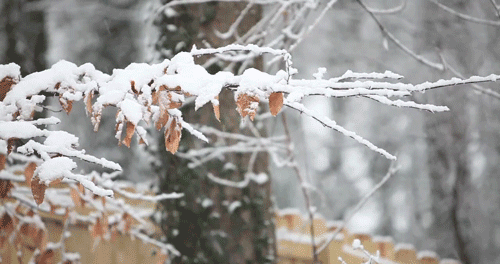
Or, a few ideas of routine pagan stuff I personally engage in, or wish to start engaging in.
Opening the curtains and taking a quick moment to appreciate the daylight (or the darkness) of the outside. Draw from it the energy you will need for the day!
After waking up, saying a short prayer to a deity of your choice (you could very well change it up based on your intent, or always pray to the same if you are devoted to one in particular). A simple “Good morning. I will try to honor you today” shows that you’re thinking of them!
Taking a little time every once in a while to learn about local plants, trees or fauna! Little by little, you’ll learn to recognize them when out in nature. Nothing more rewarding!
Playing a song, or simply instrumental music that reminds you of your spirituality when doing chores, preparing for the day or the night, etc. Useful if the day-to-day makes you feel disconnected from your spirituality!
Every once in a while, cleansing a spiritual space by simply cleaning it out before lighting a fragant candle or incense. Always makes me feel refreshed!
Focusing on a picture of a deity/deities (or spirit/spirits, or ancestor/ancestors) of your choice in adoration. What can they teach you today? How can you honor them? If a new and inspiring idea comes to your mind, why not note it down!
Diffuse a smell (either by candle, incense, essential oil diffuser or else) while getting prepared for the day! If such a topic interests you, you could learn about how different smells affect us, and how you can use that in this specific ritual. With what intent do you wish to start your day?
If you have a book/books on mythology that pertains to your deity/deities or their related culture, why not read a few pages every once in a while, just for fun! Like the song/music I mentioned before, this an easy way to start your day thinking of your spirituality.
Looking up art: depictions of deities, or if you worship nature spirits, pictures of the animal or plant the form of which it takes.
Adopting a deity’s symbol for the day! You can do that by wearing a piece of devotional jewelry, or even drawing a rune/sigil/symbol on your skin so as to keep the deity in mind.
If you’re reading this, it means you use tumblr! Why not use such social networks to talk to other pagans who share your practices? There’s lots to learn from each other! Plus, you may make good friends this way.
Look outside, observe the weather. What color’s the sky? How strong is the wind blowing? In what direction are the clouds being blown? Stay in tune with nature! You may even become able to tell which signs foretell which weather events!
Make stuff you find in nature into amulets. For example, if a leaf, rock, acorn, fallen branch or else catches your attention, why not bring it home as a lucky charm? If you possess such a skill, you could even make it into jewelry!

#paganism#polytheism#witchcraft#norse paganism#heathenry#norse polytheism#pagan tips#tips#witchy tips#deity work#deities#spirit work#animism#norse gods
2K notes
·
View notes
Text
being connected with nature does not mean needing to be friends with all of it. we’re all one and we’re all family and im still gonna have beef with cousin mosquito
#no but really you can have conflicts with nature and still appreciate it/love it and whatever#and sometimes it’s gonna have conflicts with you#nature#nature witch#witchcraft#witch#paganism#animism#handmadeorganicpost
898 notes
·
View notes
Text
How I Get the Most Out of Meat When Cooking

As someone who 1.) was 100% vegetarian for ethical/religious reasons until very recently, and 2.) recently had to reintroduce meat for vitamin deficiency reasons, limiting waste as much as possible when I cook with meat is really important to me. For one thing, I feel like I owe it to the animal that died to get as much use as possible out of its body as a way of honoring its death. For another, meat is expensive (ethically raised meat even more so) and I want to get my money's worth.
I recently bought a bunch of lamb for my family's holiday dinner, so I wanted to share my attempt to practice the Honorable Harvest in my meat consumption. This is new to me, but I wanted to document the attempt because it's been a fun learning process for me! If you want to actually learn about honorable consumption I encourage you to read the works of Robin Wall Kimmerer and other indigenous ecologists, since the Honorable Harvest is based on indigenous North American practices. (Though there are other cultural practices all over the world.)
Step One: Sourcing the Meat
I am very fortunate to have enough disposable income to buy ethically raised meat, which tends to be more expensive. This is a privilege. Other people are not able to spend this extra money on their meat, and that doesn't make me better than them. Feeding yourself is morally neutral, and a tight budget is not a moral failing. Most meat alternative products (Beyond Beef, Impossible, etc.) are also pretty expensive. If the factory-farmed meat at the supermarket is the only thing in your budget, use that.
If you DO have some extra funds, local farms are a great place to source meat. The reason we had lamb for the holidays is because a local farm recently culled their herd and had lamb on sale. In the past we've gotten beef from a relative who raises cattle. I encourage you to learn about farms in your area and what they have to offer. CSAs and farmers' markets are great places to start. You can also ask around at local restaurants about where they source their ingredients.
When I say "ethically raised meat," what I'm really talking about is pasture-raised animals. Cage-free animals may not live in cages, but they can still be kept in cramped, dirty, inhumane conditions and be sold as "cage free." Pasture-raised animals are able to graze and forage and generally wander around within a paddock. For some animals like chickens you can also look for "free range," which means the animals are unfenced and are able to wander freely. Since I don't cook meat often, I try to get free range or pasture-raised meat when I do buy it.
In some areas, you may also be able to find certified ethically slaughtered meat, which means the slaughtering process has been designed to cause as little suffering to the animal as possible. That kind of certification isn't really available where I live, but it might be for you!
And of course, hunting or fishing yourself is also an option. If you kill the animal yourself, you know exactly how it died and can take steps to limit suffering as much as possible. Hunting isn't a skillset I have, but if you do more power to you!
Step Two: Cooking the Meat
This is the easy part. Depending on the cut of meat you got and the dish you are cooking, you may need to remove bones or trim fat, but aside from that it's just following a recipe.
For our holiday lamb stew, I used this recipe. I have Celiac disease, so I subbed gluten-free flour and replaced the beer with red wine. I also added rosemary and garlic for a more Mediterranean flavor to compliment the wine.
Step Three: Organs and Bones
This is where the breakdown is for a lot of Americans. We don't cook with bones or organs very often, and we tend to throw away whatever parts of the animal we don't want. That is not honorable consumption. Part of the Honorable Harvest is using every part of the being that died to feed you.
Most organs make great stew meat. My favorite Nicaraguan beef stew is made with tongue, and my indigenous Hawaiian relatives make stew with pig feet. And while I don't like them, lots of my Southern family members love chitlins (pickled pig intestines). Lots of cultures eat organs, and you'll find plenty of delicious recipes if you look!
Bones are typically used to make stock, which can be used as a base for future soups and stews. There are lots of recipes for DIY stocks and broths, but I usually fry some onions and/or garlic, deglaze with wine, and then add the meat/bones and the water, plus salt, pepper, and herbs for flavor. Most animal bones can produce two batches of stock before they lose flavor. (For really flavorful stock, leave some meat on the bones.)
Once the stock is done, you'll still have bones to deal with. Contrary to popular belief, cooked bones are not safe for dogs to chew on. (But raw bones usually are!) Instead, I strip any remaining meat and gristle from the stock bones, give those scraps to my pups as a treat, and then use the stripped bones for something else. With a little extra processing, the bones can be used as a fertilizer in a garden, a calcium supplement for chickens, or a safe treat for dogs and/or cats.
This was my first time processing bones, but after boiling them for, like, 12 hours in water with salt and vinegar, they were soft enough to break apart with my hands. I'm going to grind them to make bone meal.
#long post#cooking#the honorable harvest#robin wall kimmerer#sustainable cooking#sustainable#sustainability#animism#kitchen witch#kitchen witchcraft#kitchen witchery#green witch#green witchery#solarpunk#cottagecore#food waste#mine#my writing
254 notes
·
View notes
Text
On animism
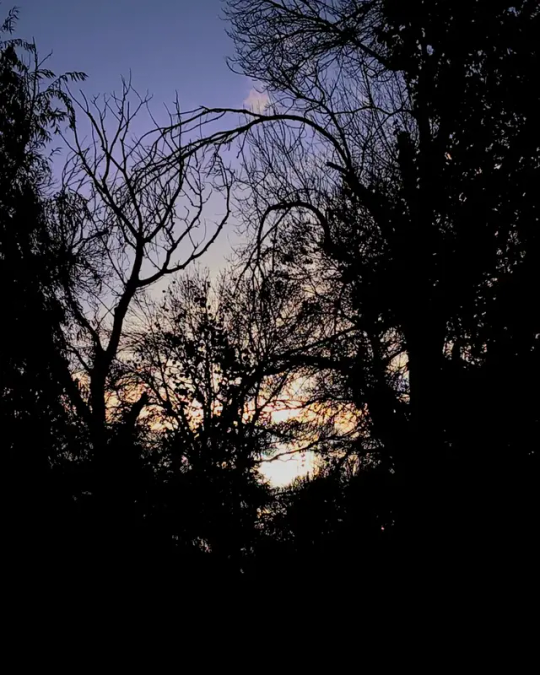
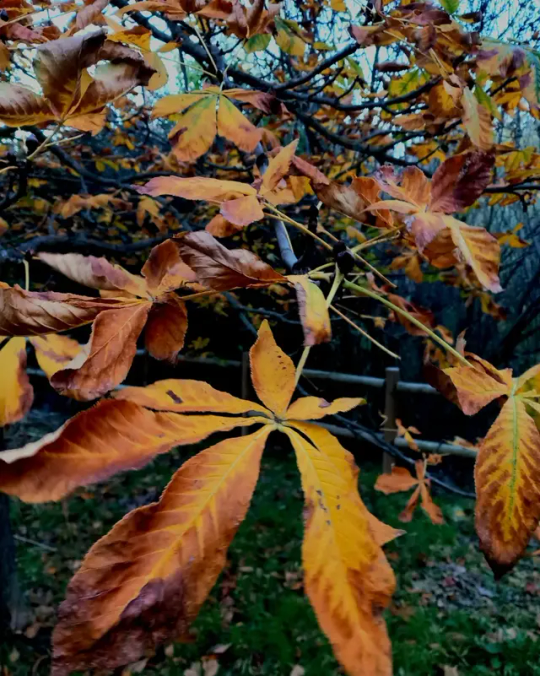
One of my teachers at university told us something today, that I believe to be relevant to animism and therefore also witchcraft:
He explained that in the West we see everything as occurences, whereas in some languages the same happenings are described as actions. Meaning that in the West we tend to imply that there is no agency involved in whatever happens, while some other languages tend to imply that someone activily causes things. His example was that in the West rain is understood as something that just happens, no one causes the rain. Whereas in Mesoamerica it was believed that it rained because some god was crying.
While the idea of a literal crying god causing it to rain on earth might be outdated, I find it really interesting how these two perspectives - events vs. actions - might shape our relationship with the world. If rain is not just an occurence, but someone acting with agency, rain becomes another part of the community we live in. The community then doesn't only consist of humans anymore, but of everything that surrounds us. Suddenly there are all these new players that actively affect your life with their actions. Other-than-human persons that you can interact with and with whom you have to keep a friendly relationship. If the tree in front of your house isn't just an object, but a being with agency, you actually have to be at least respectful and might even want to build a relationship with them, get to know them, learn from them.
I think that's really the core of animism. Descriptions of animism are often reduced to the believe that everything has a soul, but I think believe doesn't even factor into it. You don't need to believe that there is a non-physical aspect to rain, mountains, stones. It's about how we interact with them. I don't even have to ask myself the question if the tree in front of my house has a soul in order to learn about and from them or to interact with them. In my opinion animism is something that is done, not thought or believed. It's a perspective.
Listening to my teacher also reminded me of the following part of Braiding Sweetgrass (great book btw) which explains all this really well:
A bay is a noun only if water is dead. When bay is a noun, it is defined by humans, trapped between its shores and contained by the word. But the verb wiikwegamaa - to be a bay - releases the water from bondage and lets it live. "To be a bay" holds the wonder that, for this moment, the living water has decided to shelter itself between these shores, conversing with cedar roots and a flock of baby mergansers. Because it could do otherwise become a stream or an ocean or a waterfall, and there are verbs for that, too. To be a hill, to be a sandy beach, to be a Saturday, all are possible verbs in a world where everything is alive. Water, land, and even a day, the language a mirror for seeing the animacy of the world, the life that pulses through all things, through pines and nuthatches and mushrooms. This is the lan- guage I hear in the woods; this is the language that lets us speak of what wells up all around us.
[...]
This is the grammar of animacy. [...] In English, we never refer to a member of our family, or indeed to any person, as it. That would be a profound act of disrespect. It robs a person of selfhood and kinship, reducing a person to a mere thing. So it is that in Potawatomi and most other indigenous languages, we use the same words to address the living world as we use for our family. Because they are our family.
To whom does our language extend the grammar of animacy? Naturally, plants and animals are animate, but as I learn, I am discovering that the Potawatomi understanding of what it means to be animate diverges from the list of attributes of living beings we all learned in Biology 101. In Potawatomi 101, rocks are animate, as are mountains and water and fire and places. Beings that are imbued with spirit, our sacred medicines, our songs, drums, and even stories, are all animate. The list of the inanimate seems to be smaller, filled with objects that are made by people.
[...]
The language reminds us, in every sentence, of our kinship with all of the animate world.
- Robin Wall Kimmerer, Braiding Sweetgrass: Indigenous Wisdom, Scientific Knowledge and the Teachings of Plants (2013), p. 78-80.
#animism#witchcore#witch blog#witchcraft#witch books#braiding sweetgrass#witchy#folk witchcraft#folk magic#plant witch#bookblr#bookish#booklr#studyblr#animist
292 notes
·
View notes
Text
A while back ago I had a lil rant about the pagan/heathen/witch community and made this list with my friend about some problematic aspects about our craft/faith/practise or what ever you call it to help pepole who are new to it.
Idk if it any of worth or if anyone will bother to read all this but I hope its somehow helpfull for you new ones to this path.
(Pardon my 🇬🇧, im a 🇸🇪)
1. Not every polytheist does magic or has an intrest in it and thats ok.
2. Not every norse heathen knows runes or has to know every Rune and meanings to have a meaningfull relation to the gods and nature.
3. Not every raven is a sign of Odin, sometimes it just means you saw a raven and thats just as good if not better if you ask me.
4. Being able to quote havamal in old norse or know every myth and kenning of the gods is good. But does not mean you have a stronger spirital connection the land and the gods then those who dont know it all. It just means you are good at reading. And that in it self is something you should take pride in.
5. A good acorn and some dirt is just as good if not better than any long ritual with ancient chantings sourounded by a collection of crystals.
6. The pebble you find on a walk can shine just as fine on your altar, as the amethyst that was mined and payed for.
7. Your altar dont have to look Nice, it just need to feel Nice.
8. An offering dont have to be big to work. It just have to mean something.
9. Offering one loaf of bread you baked with your own two hands, is worth more than five loafs you payed somone to bake.
10. Just because a pebble dont have a story, does not mean it never had one. And just because a star has a story, does not mean its a good one.
11. If all nature is holy, that includes the parts you dont like or find nasty. Yes even ticks and spiders, mud and horrnets. No one said you had to like holy things.
12. Your body is a temple yes, but you and only you decides what rites and offerings are right the god within said temple.
13. You can still be a drunk horny ape and be spiritual.
14. No illustration of the gods is more corect or more true to their form.
But then there is no garantee everyone will see who its meant to be. And thats ok.
15. Doing spirtual junk and practise magic or healing does not make you more enlightened...
16. Just because you wrote a book about magic, healing and spiritual matters, does not make it a good book or you a good author.
17. Just because someone you look up to said it, does not make it more right. It just means they said it.
18. Making this list to remind the pagan/witch/heathen community to hummble them selfs does not make me better. Im also doing this to just remind myself. Im not better or wiser than any of you lot.
19. Dont ever expect to have your craft respected if you dont give that same respect back to others.
20. It does not matter how old or big your coven or group is. If it has toxic and harmfull parts that clearly hurt and or make pepole unhappy. Then its ok to criticize it. Age or size does not make it untuchble.
21. If a craft or faith says its all about nature but cant change its ways, then it has clearly missed a very important thing about how nature works.
22. Every rock is an altar and every forest is a temple.
23. For every horn of mead you offer to the gods, you should plant at least one seed.
24. If all in this world has a spirit and is alive, does not mean you cant take space and exist and live in it.
25. Its not about beliving. Its about to experience and to perceive. That if you ask me, is the core of animism and polytheism.
#polytheism#heathen#pagan polytheism#norse polytheism#pagan#paganism#fornsed#nordic animism#animism#wicca#witch#spiritual
710 notes
·
View notes
Text
Your body is an ancestor. Your body is an altar to your ancestors. Every one of your cells holds an ancient and anarchic love story. Around 2.7 billion years ago free-living prokaryotes melted into one another to form the mitochondria and organelles of the cells that build our bodies today. All you need to do to honor your ancestors is to roll up like a pill bug, into the innate shape of safety: the fetal position. The curl of your body, then, is an altar not just to the womb that grew you, but to the retroviruses that, 200 million years ago taught mammals how to develop the protein syncytin that creates the synctrophoblast layer of the placenta. Breathe in, slowly, knowing that your breath loops you into the biome of your ecosystem. Every seven to ten years your cells will have turned over, rearticulated by your inhales and exhales, your appetites and proclivity for certain flavors. If you live in a valley, chances are the ancient glacial moraine, the fossils crushed underfoot, the spores from grandmotherly honey fungi, have all entered into and rebuilt the very molecular make up of your bones, your lungs, and even your eyes. Even your lungfuls of exhaust churn you into an ancestor altar for Mesozoic ferns pressurized into the fossil fuels. You are threaded through with fossils. Your microbiome is an ode to bacterial legacies you would not be able to trace with birth certificates and blood lineages. You are the ongoing-ness of the dead. The alembic where they are given breath again. Every decision, every idea, every poem you breathe and live is a resurrection of elements that date back to the birth of this universe itself.
Today I realize that due to the miracle of metabolic recycling, it is even possible that my body, somehow, holds the cells of my great-great grandmother. Or your great-great grandmother. Or that I am built from carbon that once intimately orchestrated the flight of a hummingbird or a pterodactyl. Your body is an ecosystem of ancestors. An outcome born not of a single human thread, but a web of relations that ripples outwards into the intimate ocean of deep time.
Your Body is an Ancestor, Sophie Strand
#text#Your Body is an Ancestor#Sophie Strand#embodiment#ancestry#animism#ecology#relatedness#kinship
5K notes
·
View notes
Text


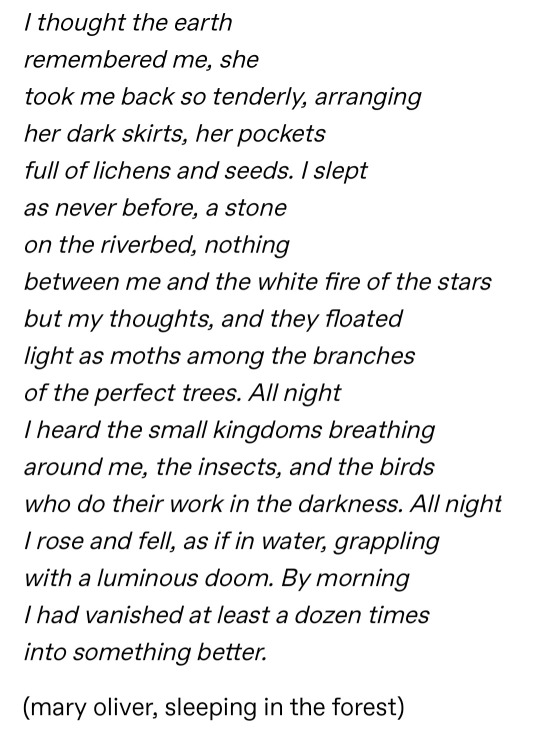
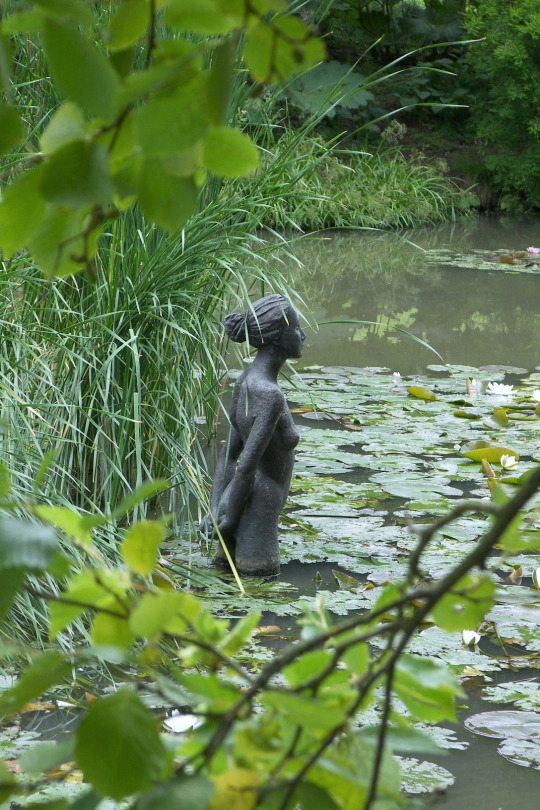





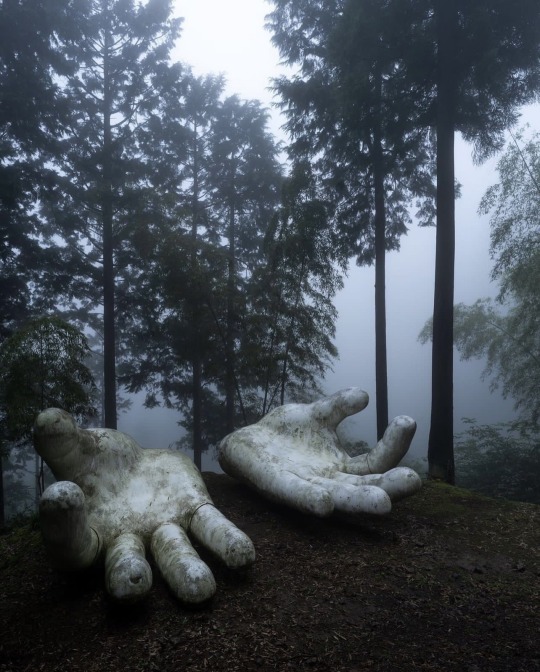
Credits:
Trees may have a ‘heartbeat’ that is so slow we never noticed it by Andy Coghlan / The Spirit of the Medieval Hunter, Anna & the Willow, Willow Sculpture (2018) / Mary Oliver, Sleeping in the Forest / Lady In The Water at Sir Harold Hillier Gardens (2008) / Quote fragment from Knut Hamsun / 'Thrive' by Daniel Popper (2020) / Quote fragment from Tales From Earthsea by Ursula K. Le Guin / Nesting in the crown of Mary at St. Ottilien Archabbey, Oberbayern, Germany / Quote fragment from 'The World Keeps Ending, and the World Goes On' by Franny Choi / Abandoned Stone Hands Sculpture, Japan
#artemis#artemis deity#artemis goddess#artemis worship#artemis devotee#artemis devotion#quotes#nature#nature quotes#nature photography#animism#helpol#hellenic polytheist#hellenic paganism#diana#diana deity#diana worship#diana devotee#diana devotion#e offering
174 notes
·
View notes
Note
🔥Animism
The “everything has a spirit” style of animism that I practice is not as scary and overwhelming as a lot of people seem to think it is. It has made me respect inanimate objects more, and really develope what I mean which I say “everything has a spirit,” which takes a lot of work in a consumerist/capitalist culture and I think people are afraid of that work as much as they are afraid of anything else.
149 notes
·
View notes
Text

Victor Bengtsson (Danish, 1997) - A Case for Animism (2023)
86 notes
·
View notes
Text
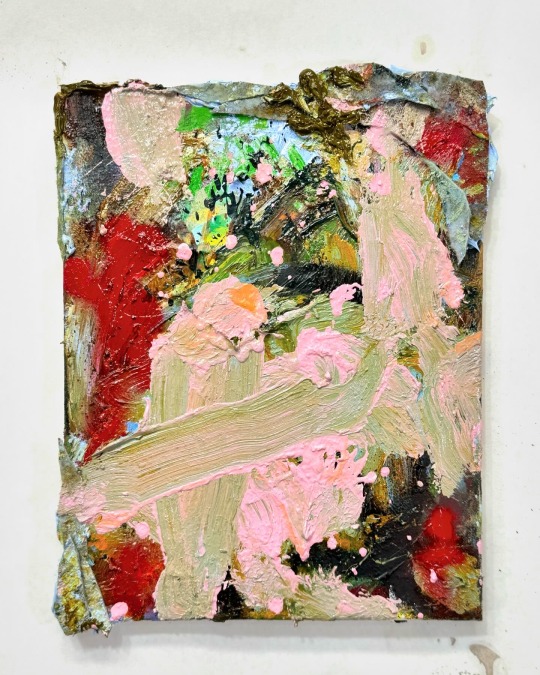
Chivito
11x14” mixed media
R.A.Young 2024
#r.a.young animism#painter on tumblr#r.a.young#artists on tumblr#artist on tumblr#impasto#middens#non objective#animism#castingspellsandshit
141 notes
·
View notes